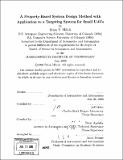| dc.contributor.advisor | Jeff Miller and Brent Appleby. | en_US |
| dc.contributor.author | Mihok, Brian E. (Brian Edward) | en_US |
| dc.contributor.other | Massachusetts Institute of Technology. Dept. of Aeronautics and Astronautics. | en_US |
| dc.date.accessioned | 2007-01-10T16:40:45Z | |
| dc.date.available | 2007-01-10T16:40:45Z | |
| dc.date.copyright | 2006 | en_US |
| dc.date.issued | 2006 | en_US |
| dc.identifier.uri | http://hdl.handle.net/1721.1/35571 | |
| dc.description | Thesis (S.M.)--Massachusetts Institute of Technology, Dept. of Aeronautics and Astronautics, 2006. | en_US |
| dc.description | Includes bibliographical references (p. 251-253). | en_US |
| dc.description.abstract | The aim of system design is to define an optimal integration of components for the achievement of an overarching objective. As a result, engineering systems often cannot be designed with the disciplines meeting in isolation, but instead require collaboration for a synergism of goals, especially in aviation-based systems where tradeoffs are inherent to the design. Furthermore, defense-related projects require a strict acquisition process that requires companies to submit proposals for contracts. The system design method proposed here is geared towards the proposal stage of design and is aimed at enabling objective, informed design decisions. As such, the method uses the system's properties in a utility function-based evaluation to determine the best alternative. Towards these ends, the method defines criteria critical to the system's evaluation and functions to translate the system's properties related to these criteria into scores. The system's properties are derived from relationships with the components properties and between the components and their environment. As a result, the method translates component properties into system properties, which are then turned into scores. | en_US |
| dc.description.abstract | (Cont.) A utility function is used to create a total system utility for the alternative, which serves as the basis for comparison. A Python-based tool was written to facilitate the method, encapsulating the process in a high-level, easily configurable script. The method was demonstrated on the design of a targeting system for small UAVs. Three targeting methods were considered: assuming a flat Earth, using DTED data, and using range data. The evaluation revealed a descending utility order of DTED, Flat Earth, and Range based upon the system's stated requirements. While the Range method produced the most accurate results by far, its unit cost was well beyond the allocated budget, as was its power. DTED data was found to be a beneficial addition to small UAVs. In the evaluation, the method was able to elucidate the key information required to shape the design and thus showed promise. | en_US |
| dc.description.statementofresponsibility | by Brian E. Mihok. | en_US |
| dc.format.extent | 253 p. | en_US |
| dc.format.extent | 17314651 bytes | |
| dc.format.extent | 18211778 bytes | |
| dc.format.mimetype | application/pdf | |
| dc.format.mimetype | application/pdf | |
| dc.language.iso | eng | en_US |
| dc.publisher | Massachusetts Institute of Technology | en_US |
| dc.rights | M.I.T. theses are protected by copyright. They may be viewed from this source for any purpose, but reproduction or distribution in any format is prohibited without written permission. See provided URL for inquiries about permission. | en_US |
| dc.rights.uri | http://dspace.mit.edu/handle/1721.1/7582 | |
| dc.subject | Aeronautics and Astronautics. | en_US |
| dc.title | A property-based system design method with application to a targeting system for small UAVs | en_US |
| dc.type | Thesis | en_US |
| dc.description.degree | S.M. | en_US |
| dc.contributor.department | Massachusetts Institute of Technology. Department of Aeronautics and Astronautics | |
| dc.identifier.oclc | 74277798 | en_US |
